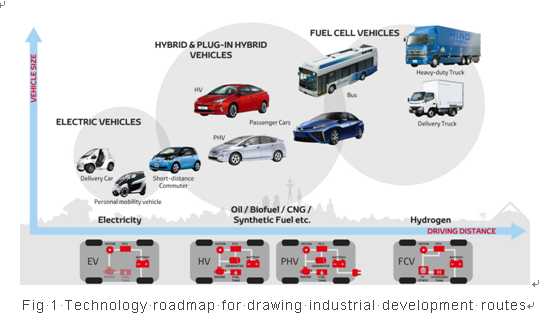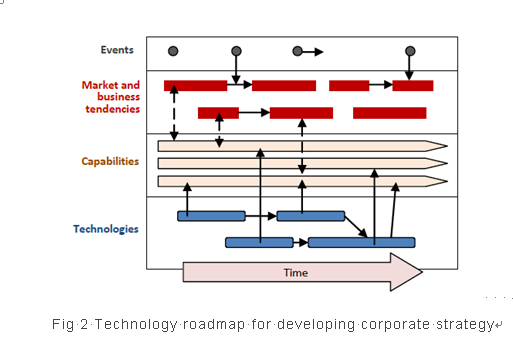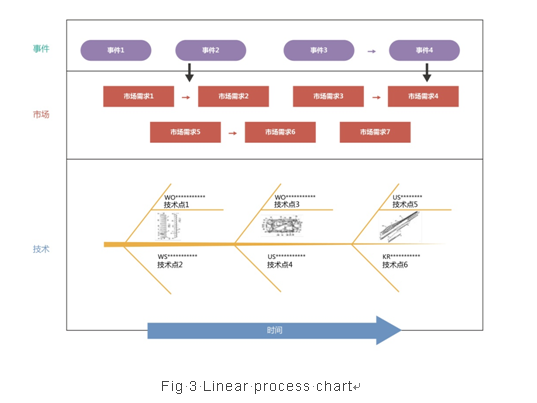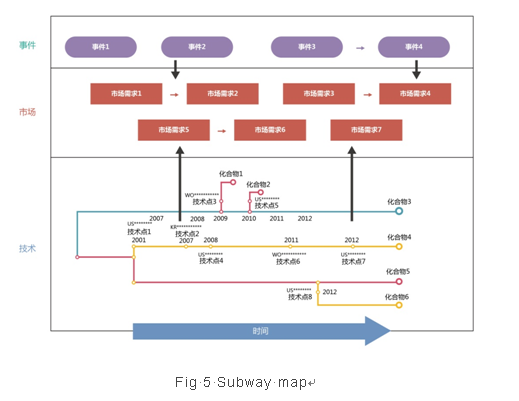
Foreword
The drawing methods of technology roadmap include Delphi method, brainstorming, expert talk method and computer method, etc. With the rise of patent information research, the application of patent in the technology roadmap has gradually attracted more attention. The advantages of combining subjectivity and objectivity also make it a useful supplement to the existing drawing methods. Since patent information can objectively reveal technological developments, combining patent information with industrial information in the application reflects the technical dimensions of the technology roadmap, which can further enrich and expand the existing technology roadmap.
1. Definition
Technology roadmap [1] usually refers to describe the steps of technology change or logical relationship between technology-related links with the application of concise graphics, tables, text, etc.
The technology roadmap has been widely used around the world, but there is no unified and standardized definition due to the different application subjects, scenarios, purposes, and methods.
One definition of a technology roadmap is: A technology roadmap is a view of the future extension for the development of a specific field. This view reflects the collective wisdom and the view of the most significant drivers of technological change [2]. In addition, according to another definition of Industry Canada: The technology roadmap is a process tool that helps to identify the key technologies required by the industry/company/department for future success, and the projects or steps required to obtain these technologies for implementation and development [3].
2. The role of the technology roadmap
The technology roadmap has been widely used in the formulation of national development strategies, industrial development strategies, and enterprise development strategies.
At the industrial application level, the technology roadmap is used to draw out the industrial development route and direction. At the enterprise application level, the technology roadmap is used for more micro-level aspects including technical planning and product development, such as product parameter performance [4].
Figure 1 shows the application of the technology roadmap in the automotive industry. This figure points out the development route of new energy vehicles from pure electric vehicles, hybrid vehicles to fuel cell vehicles.

Figure 2 is the application of technology roadmap in corporate strategy formulation. Among them, the abscissa reflects the evolution of technology, company capabilities, market demand, and current affairs policies over time, and the ordinate reflects the linkage relationship between technology development and company capabilities, market demand, and current affairs policies [5]. This type of technology roadmap can help companies make macro R & D strategies.
It can be seen from the application at the industry and company level that the technology roadmap is a structured planning method. It can unify the past, present and future horizontally, and can present different categories vertically, both describing the current situation and predicting the future. As a method, it can be widely used in technology planning management, industry future prediction, and formulating future product strategies.

3. Formulation of traditional technology roadmap
The traditional methods of formulating the technology roadmap include the Delphi method, brainstorming method, expert talk method, and computer method. The Delphi method refers to the acquisition of relatively objective technical information through independent and repeated subjective judgments (back-to-back investigation) by multiple experts. The computer method obtains technical information and related information by mining technical data.
Among the above methods, the Delphi method, brainstorming method, expert talk method, etc. are subjective methods; and the computer method to determine the technology roadmap is objective method, which predict the future development direction through analysis of the current status of technology and even quantify the results.
The pros and cons of various types of technical roadmap formulation methods are different. The subjective discussion method will make full use of the technical advantages of industry experts and reflect the experts' prediction of technology. The objective method will focus on digging deep into the internal correlations from the computer. At present, some technical route predictions in the industry are based on this method. The disadvantage of the subjective discussion method is that it only considers the subjective opinions of experts and lacks objective data support. Although the objective method is based on the original data, it does not combine the experience of experts in the judgment of key links. Therefore, it is necessary to balance the advantages and disadvantages of the subjective and objective methods in the actual operation process.
4. How to draw a patent technology roadmap
Compared with the traditional technology roadmap, the patent technology roadmap has the advantages of objectiveness, comprehensiveness, and outstanding details. Patents are the protection of products and R & D innovation achievements. Through the disclosure of technical issues, technical effects, and technical means, technology is granted legal protection. At the same time, some key elements in the technology roadmap are usually technical goals, technical barriers and key technologies that affect the development of industries or enterprises, and these key elements are reflected in the patent precisely because of the disclosure requirements of the patent itself. In addition, unlike technical theoretical research, patents carry the products or R & D projects developed by enterprises. Therefore, they reflect not only the trend judgment of enterprises in theory, but also the specific actions of enterprises in practice, and the investment of the actual product and technology resources from the enterprise. Overall, in the process of researching the technology roadmap, the above research results will provide reliable information support for the knowledge of expected goals, technical barriers, and key technologies.
The patent technology roadmap will make use of typical representative patents and describe the logical relationship between technological change steps or technological related links in the form of graphics, tables, and text. Because the classification of technology roadmaps is extremely complex (such as product technology roadmaps, problem-oriented technology roadmaps, emerging technology roadmaps, industry roadmap patents, etc.), it needs to be adjusted according to different application scenarios when drawing a specific technology roadmap. Generally speaking, the following important aspects are involved during the drawing process of the technology roadmap:
(1)Basis for drawing patent technology roadmap
Compared with the basis for drawing the traditional technology roadmap, the patent technology roadmap also needs to consider the evolution of market policy requirements over time. The difference between them is that in the technical dimension, the traditional technology roadmap only considers the views and opinions of experts, or only the technical information reflected in the non-patent resources, while the technical dimension of the patent technology roadmap will consider the combination of patent and non-patent information as the basis for drawing the road map.
The drawing of the patent technology roadmap is mainly based on the patent literature, and through the analysis of patent information, various typical representative technologies, new technologies in the field, and complete patented technologies related to product technology routes can be obtained. However, considering that some technologies are only disclosed in detail in the non-patent literature, and are conducive to the selection of typical representative patents and the grasp of the development direction of the technology, it is necessary to pay attention to the value of non-patent information. Therefore, it is better to collect both relevant patent information and non-patent information when drawing the patent technology roadmap.
(2). Selection and confirmation of typical representative patents
The key technical elements of the traditional technology roadmap come from the consensus of some experts or from representative technologies selected from objective data. Compared with the basis of the traditional technical roadmap, the key elements of the patent technology roadmap come from the typical patents selected by the technical staff in the specific technical field. The selection of these typical patents is one of the core work because these patents represent the technological development at a specific time point or time period.
Generally speaking, when selecting a typical patent, it is necessary to consider the following aspects together with relevant information such as the market for making a more comprehensive judgment.
1)Whether the patent reflects the common choice of leading companies in the industry;
2)Whether the patent reflects the needs of the market or solves the technical problems that need to be solved urgently in the industry or is related to key technologies;
3)Whether the patent reflects the latest technological trends.
During the actual operation, you can first use the company's own input indicators (such as the number of patents of the same family), as the basis for subsequent technologies (such as the number of citations), and the right holders of leading companies as the initial screening basis, and then combine the above judgment factors to make the final choice.
(3). Elements association of the patent technology roadmap
The elements of a patent technology roadmap involve technology, events, markets, etc. The logical relationship among the above elements or the same type of elements is an important content in the process of drawing the patent technology roadmap.
When establishing the connection of the above elements, it is necessary to consider the vertical correlation of representative technologies at different time points on the time axis, the derivative evolution relationship between technologies, and the correlation of representative technologies within the same period of time to construct vertical and horizontal development of technology. In addition, the correlation between technology, events, and markets is important for understanding and predicting the development of technology.
(4). Drawing of a patent technology roadmap
The technical roadmap itself is very flexible, and the expression of technical roadmaps based on different goals also varies. Generally, multi-level expressions based on time are used [6]. Compared with the traditional technology roadmap, there are basically no major changes in the expression of the patent technology roadmap, but through the typical representative patent, the trend and development of the entire technology can be constructed.
At present, technology development roadmaps mainly include linear progress charts, swim lane charts and subway maps, etc. The linear process chart is used to show the technological evolution of a single technology or product; the swim lane chart is used to display the technological evolution of multiple technologies or products on the same time axis; Compared with the swim lane chart, the improvement of the subway map is that the fixed timeline is eliminated. The following are examples of three different technology development roadmaps for integrated events, markets, and technologies.



The above content is only a preliminary introduction to the patent technology roadmap, and the author will further elaborate through application examples in different situations in the following articles.
References:
1.http://wiki.mbalib.com/wiki/%E6%8A%80%E6%9C%AF%E8%B7%AF%E7%BA%BF%E5%9B%BE
2. 技术路线图的发展与应用分析,李栎。
3. 基于战略愿景与使命的产业技术路线图研究,佟瑞。
4. 国内外技术路线图典型案例分析,李海丽。
5. Technology Roadmapping,MBA Luis Bernal.
6. Technology Roadmapping,Robert Phaal,Centre for Technology Management,University of Cambridge,United Kingdom.
Follow us






